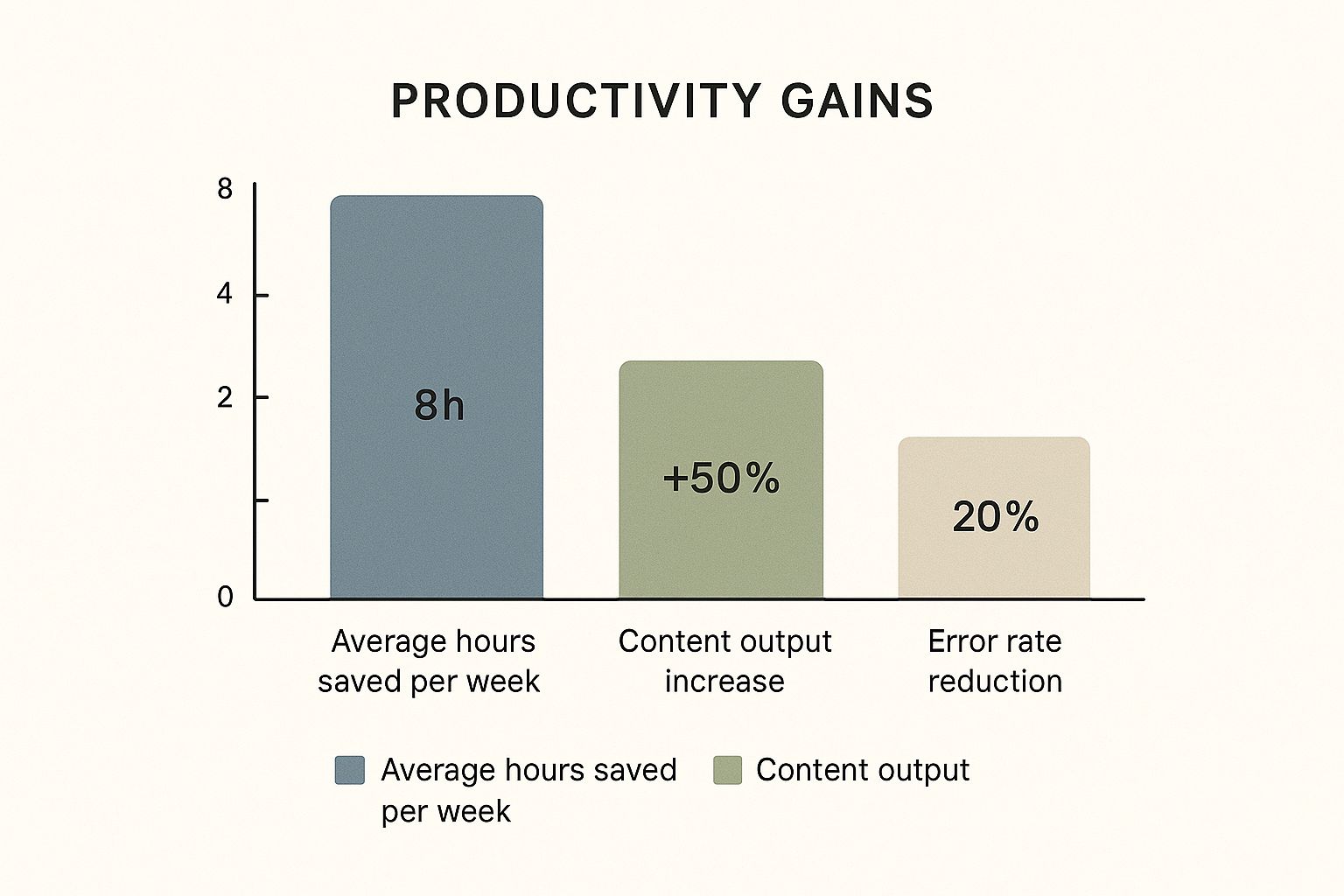7 Ways to Automate Content Creation Effectively

Why Content Automation Is No Longer Optional

The content world has changed. To stay competitive, businesses need not just good content, but lots of it, delivered regularly. This presents a real challenge: how to balance quality with the constant demand for more. Traditional content creation, while valuable, often slows things down. For example, relying only on human writers can be costly and time-intensive, limiting output. This means missed chances to connect with audiences and build engagement.
Maintaining a consistent brand voice across different platforms also gets tricky with manual processes. This inconsistency can weaken brand identity and confuse your audience. However, businesses that have adopted content automation are seeing real results, often outperforming competitors by 3-5x in content output. This increased productivity helps them dominate search results, connect better with audiences, and ultimately, grow their business. This success is making AI-assisted content more mainstream, showing its clear value in modern marketing. For more insights on LinkedIn content, check out this resource: 7 Types of Content to Boost Your Presence on LinkedIn.
Challenges of Manual Content Scaling
Increasing content production manually comes with its own set of problems. Keeping content quality high and consistent becomes harder as volume grows. Teams often struggle to stick to brand guidelines, resulting in variations in tone and messaging. Plus, the heavy workload can lead to burnout and stifle creativity among content creators. This directly impacts the quality and effectiveness of the content. The generative AI content creation market is experiencing rapid growth. It’s projected to jump from $11.6 billion in 2023 to $175.3 billion by 2033, a 31.2% compound annual growth rate. This growth reflects the widespread adoption of AI tools across many industries, with North America leading the way. Companies using AI content tools report an average 32% reduction in production costs while maintaining quality, demonstrating the efficiency and scalability of these tools. Learn more here: Generative AI in Content Creation Market.
How Automation Solves These Challenges
Automating content creation offers solutions to these problems. AI tools like Jasper.ai can maintain a consistent brand voice and messaging across all platforms. They can also manage time-consuming tasks like content formatting and optimization, freeing up human writers to focus on strategy and creative work. This collaborative approach maximizes efficiency and allows businesses to scale content production without compromising quality. The data chart below shows the projected growth of the content automation market over the next ten years, highlighting the increasing demand for these solutions.
Content Automation Market Growth Projection (2023-2033)
(This space is reserved for a bar chart infographic visualizing the data mentioned above. The chart will highlight the year-over-year growth and emphasize the dramatic increase in market value, visually reinforcing the importance of adopting content automation.)
This upward trend clearly shows that automating content creation is essential for businesses to stay competitive and succeed.
To further illustrate the benefits of automation, let's examine some common content creation challenges and their automated solutions.
Content Creation Challenges & Automation Solutions
| Challenge | Traditional Approach | Automation Solution | Business Impact |
|---|---|---|---|
| Maintaining Consistent Brand Voice | Manual style guides and reviews | AI-powered writing tools ensure consistent tone and style | Reduced revisions, improved brand recognition |
| Scaling Content Production | Hiring more writers, increasing workload | Automated content generation tools create large volumes of content quickly | Increased content output, faster time to market |
| Content Optimization (SEO) | Manual keyword research and optimization | AI-powered SEO tools automate keyword research and content optimization | Improved search rankings, increased organic traffic |
| Content Repurposing | Manually reformatting content for different platforms | Automation tools repurpose content across various formats (blog posts, social media, email) | Wider content reach, increased content ROI |
This table highlights how automation addresses key content creation challenges, leading to significant improvements in efficiency, scalability, and overall business impact. By automating tedious and repetitive tasks, businesses can free up their human talent to focus on higher-value activities like strategy and creative development.
The Essential Toolkit for Content Automation Success

Successfully automating your content creation process depends heavily on choosing the right tools. What works for a small business owner might not be suitable for a large marketing agency. Understanding the strengths and weaknesses of each tool and how it fits into your current workflow is key. Choosing wisely will help you build effective automation pipelines and scale your content production.
Tools for Automating Written Content
For written content, AI-powered tools like Jasper.ai (Jasper.ai), Hypotenuse.ai (Hypotenuse.ai), and Rytr (Rytr) offer robust writing assistance. These tools can generate various content formats, including blog posts, social media updates, ad copy, and product descriptions.
Remember, these tools are best for shorter pieces of text. Longer-form content still needs human review to ensure quality and authenticity. SEO tools like Clearscope (Clearscope) and Surfer SEO (Surfer SEO) can boost your SEO efforts by creating optimized content briefs and finding internal linking opportunities.
Tools for Automating Visual Content
Visual content automation offers a different set of tools. Bannerbear (Bannerbear) automatically generates images based on templates and data sources. This is particularly helpful for creating social media graphics, ad banners, and other marketing materials.
Bannerflow (Bannerflow) and Celtra (Celtra) specialize in dynamic images for digital advertising, streamlining visual content production. For AI avatar generation, platforms like HeyGen (HeyGen), Synthesia (Synthesia), and D-ID (D-ID) provide innovative solutions for creating personalized video content with virtual presenters.
Tools for Automating Video Content
Video content automation has immense potential for scaling production. Lumeo (Lumeo) excels at transforming written content into engaging carousel presentations for various social media platforms. These presentations are visually appealing and informative, designed to drive engagement.
Plainly (Plainly) automates video creation through templates that you populate with data, rendering multiple video variations with minimal manual work, potentially saving up to 85% of production time.
To illustrate the variety of options available, the table below provides a detailed comparison of some leading AI content automation tools.
Before we dive in, here's a brief overview of what this table covers: it compares the top AI content automation tools based on their key features, ideal use cases, pricing models, integration options, and the skill level required to use them effectively. This will give you a clearer picture of which tools might best suit your specific content creation needs.
Top AI Content Automation Tools Comparison: Comprehensive comparison of leading AI content creation tools by features, use cases, and pricing
| Tool Name | Best For | Key Features | Pricing | Integration Options | Skill Level Required |
|---|---|---|---|---|---|
| Jasper.ai | Long-form content, blog posts, marketing copy | AI writing assistant, content templates, plagiarism checker | Varies by word count and features | SurferSEO, Grammarly | Beginner to Intermediate |
| Hypotenuse.ai | E-commerce product descriptions, blog posts, social media content | AI content generation, image generation, content planning | Varies by word count and features | Shopify, WooCommerce | Beginner to Intermediate |
| Rytr | Short-form content, social media captions, ad copy | AI writing assistant, multiple language support, content rephrasing | Freemium model with paid options | Semrush, Hootsuite | Beginner |
| Bannerbear | Social media graphics, dynamic banners | Automated image generation, templates, API access | Varies by image generation count | Zapier, Integromat | Beginner to Intermediate |
| Lumeo | Carousel video presentations, social media content | AI-powered video creation, text-to-video conversion, customizable templates | Varies by video generation count | Zapier, various social media platforms | Beginner to Intermediate |
This table highlights the diversity in AI content automation tools. Choosing the right tool depends on your specific needs, budget, and technical skills. It's important to consider the key features, integrations, and pricing models before making a decision.
Integrating Tools for a Seamless Workflow
The real power of automation comes from integrating these tools. Imagine combining AI-generated text with automatically created visuals, then embedding them into a dynamic video using a tool like Lumeo. This creates a powerful content engine, producing large volumes of engaging content with minimal manual effort.
However, quality control is essential. Human oversight remains crucial for accuracy, brand voice, and adding that personal touch that resonates with your audience. By strategically combining tools and maintaining human oversight, you can achieve content automation success and significantly scale your content production.
Building Your Semi-Automated Content Engine

Moving beyond individual tools, this section focuses on building a comprehensive content system. It's about integrating various tools and processes to automate content creation effectively. Think of it as building an engine: individual parts are essential, but their real power comes from how they work together. This integrated approach helps you scale content production while maintaining quality and consistency.
Conducting a Content Audit for Automation Opportunities
Before automating anything, it's crucial to understand your current content landscape. A content audit helps identify areas ripe for automation. This means analyzing your existing content to determine which types perform well, which consume significant resources, and which would benefit from automation.
For example, frequent social media updates or product descriptions are great candidates. You might find this helpful: How to make a carousel post. This systematic approach ensures you're automating the right things for maximum impact.
Building Automated Workflows with Quality Checkpoints
Once you've identified opportunities, building streamlined workflows is key. This involves creating clear processes for content creation, from initial idea to final publication. Using templates for AI writing tools, for instance, ensures consistent brand voice and messaging.
Adding human review stages throughout the workflow maintains quality control. This combination of automation and human oversight balances efficiency and quality. Content marketers are increasingly using AI for content creation, with 43% using it for content generation and 20% allocating over 40% of their budgets to AI-driven campaigns. This shows the growing recognition of AI's effectiveness in content marketing. More detailed statistics can be found here: Content Marketing Statistics.
Developing Approval Frameworks for Automated Content
Clear approval processes are vital for maintaining quality and brand consistency. This involves defining roles and responsibilities within your content team and implementing review stages at important points in the workflow.
This structured approach prevents errors and ensures all automated content aligns with your brand standards.
Overcoming Common Implementation Roadblocks
Implementing content automation isn't always easy. Common challenges include integrating new tools with existing systems, training teams on new processes, and ensuring content quality.
Addressing these proactively is critical for success. This might involve providing training and support, establishing clear communication, and continually refining workflows based on feedback and performance data. By anticipating and solving potential problems, you can ensure a smoother transition. Ultimately, this builds a sustainable content system that scales with your business while maintaining your unique market position.
Personalization at Scale: The Automation Paradox
Creating a lot of content isn't the biggest challenge in content marketing. The real hurdle is making that content resonate with each individual viewer. That's where personalization comes in. This section explores how automation can actually amplify personalization, leading to significantly higher engagement.
Data Integration for Dynamic Content
Imagine blasting a generic email to your entire customer base. Now, contrast that with crafting unique emails designed for each individual's interests and past interactions. That's the power of dynamic content creation.
By integrating data from your CRM (Customer Relationship Management), marketing automation platform, or even social media interactions, you can empower AI tools to generate content variations automatically.
For example, a new subscriber receives a welcome email. Instead of a generic message, the email automatically includes content relevant to the specific lead magnet that attracted them. This targeted approach creates stronger connections and improves conversion rates.
Adaptive Field Insertion and Audience-Specific Variations
Adaptive field insertion is a powerful personalization technique. It uses placeholders within your content templates that automatically populate with recipient-specific data. This could be their name, location, recent purchase, or any other relevant information.
You can also create entirely different content variations for specific audience segments. Consider creating different landing pages for users coming from social media versus organic search, tailoring the message to their initial point of contact. Automation makes this level of personalization possible, ensuring every interaction feels relevant and engaging.
Leveraging Behavioral Signals for Automated Content Decisions
Automation goes beyond simply inserting personalized fields. By analyzing user behavior – website browsing history, email clicks, or social media engagement – you can automatically inform content decisions.
For example, if a user frequently browses blog posts about a specific product, the automation system can dynamically recommend related content, offer personalized discounts, or even trigger a tailored email sequence. This improves the user experience, driving engagement and fostering customer loyalty.
Furthermore, AI-driven personalization delivers impressive results. Price Elasticity of Conversion (PEC) can reach 2.7 with AI, almost three times the effectiveness of standard methods. This translates to a threefold revenue impact per optimized content piece. Engagement also gets a boost, with AI-optimized content receiving 83% more social interactions. Learn more at AI Stats for Content Marketing Success. These benefits often lead to businesses recovering their AI implementation costs within 12-18 months.
Ethical Considerations and Balancing Authenticity
While automated personalization offers significant potential, ethical considerations are crucial. Transparency in data usage is essential. Users need to understand how their information is collected and used. This builds trust and strengthens customer relationships.
Maintaining authenticity is also key. While automation improves efficiency, it shouldn't completely replace the human touch. Balancing automated efficiency with authentic, human-driven storytelling ensures personalized content remains engaging and relatable.
By carefully considering these factors and building feedback mechanisms that continually refine personalization accuracy, businesses can unlock the full potential of automated content creation while building strong, lasting relationships with their audience.
The Quality Control Playbook for Automated Content
Automating content creation offers incredible potential. Maintaining high quality, however, is absolutely essential. Think of it as a high-speed train: powerful and efficient, but requiring reliable tracks and regular maintenance. This section explores how to build quality assurance into your automated content processes, ensuring your output is both fast and excellent.
Developing Comprehensive Content Guidelines
Clear guidelines are essential for effectively directing AI tools like Jasper.ai. These guidelines serve as a detailed instruction manual, ensuring the AI understands your brand's voice, style, and messaging. This includes specifics like preferred vocabulary, tone, and even sentence structure.
For instance, instructing the AI to avoid jargon or maintain a conversational tone shapes the output to reflect your brand identity. Well-defined guidelines ensure consistent quality and prevent the AI from veering off course.
Implementing Fact-Checking Protocols
AI can sometimes generate inaccurate or fabricated information, often called hallucinations. This makes fact-checking crucial. Establish clear protocols for verifying information produced by AI tools.
This might involve cross-referencing with reliable sources or using fact-checking software. It’s like a quality control inspector on a production line, catching errors before they impact the final product. Robust fact-checking protects your brand’s credibility and maintains audience trust.
Establishing Voice Consistency Checks
Maintaining a consistent brand voice is vital for building brand recognition. While AI can be trained to emulate a specific style, regular checks are essential. This involves reviewing automated content for tone and language consistency.
Imagine a brand known for its witty, informal style suddenly publishing dry, technical content. This kind of inconsistency can confuse your audience and potentially harm your brand image. Voice consistency checks ensure your automated content sounds authentically like your brand.
Addressing Specific Quality Issues and Solutions
Certain quality issues often arise with automated content. For example, AI can sometimes overuse specific phrases or generate repetitive text. This is where human oversight becomes crucial. Developing strategies to identify and correct these issues is key.
This might involve using plagiarism detection software like Grammarly or manually reviewing for stylistic problems. Think of it as fine-tuning a musical instrument: small adjustments can make a big difference. Addressing these problems head-on keeps your automated content engaging and impactful.
When Human Intervention Is Essential vs. Automation
Knowing when to bring in human expertise is critical. AI excels at generating drafts and handling repetitive tasks. However, more nuanced aspects often benefit from human intervention.
Complex narratives or carefully crafted arguments, for example, often require a human touch. Developing clear criteria for when human intervention is needed helps maximize efficiency while maintaining quality. Think of it as a relay race: AI handles the initial leg, generating the first draft, while humans provide the final push, adding their unique insight and creative skills. This collaborative approach optimizes results, leveraging the strengths of both automation and human talent.
Measuring What Matters: The ROI of Content Automation

Investing in content automation requires demonstrating a tangible return on investment (ROI). It's not enough to simply promise increased productivity. This section provides a framework for measuring the real impact of automating your content creation process on your business. We'll look at identifying the most important metrics and how to present them effectively to stakeholders.
Establishing Pre-Automation Baselines
Before automating anything, establish clear benchmarks. Measure your current content creation process. This gives you a solid starting point to compare against later. Track essential metrics like these:
- Time spent per content piece: This helps quantify the time saved after implementing automation.
- Cost per piece of content: This should include writing, editing, and design costs.
- Content output volume: Measure how many articles, blog posts, social media updates, etc., you create weekly or monthly.
- Engagement metrics: Track likes, shares, comments, and website traffic generated by your content.
These pre-automation baselines serve as a foundation for demonstrating the clear impact of your automation strategy.
Tracking Productivity Improvements Per Content Type
Different content formats will see different benefits from automation. Automating social media updates, for instance, might save more time than automating long-form blog posts.
Track productivity gains specific to each type of content you create. This detailed approach helps you pinpoint areas where automation yields the highest ROI and allows you to refine your strategy accordingly. It also helps justify further investment in particular automation tools or processes.
Calculating True Cost Efficiencies
Cost savings go beyond simply time saved. Automating content creation can reduce your need for additional staff or freelance writers. This often translates to significant cost reductions across your operations.
When calculating overall cost efficiencies, be sure to include several key factors:
- Software costs: Factor in any subscription fees for automation tools.
- Training costs: Include the cost of training your team on new tools and processes.
- Reduced labor costs: Calculate the savings from decreased reliance on freelancers or in-house writers.
This thorough approach reveals the complete financial benefits of content automation. For more ideas on maximizing your ROI, consider repurposing existing content. Here's a resource you might find helpful: 10 Proven Content Repurposing Strategies to Boost ROI.
Assessing Engagement Differences
Compare engagement metrics between automated and human-created content. This involves examining metrics like:
- Click-through rates: How frequently are people clicking on your content?
- Conversion rates: How many clicks result in leads or sales?
- Social media shares: How often is your content shared organically?
These metrics indicate how effectively automated content resonates with your audience compared to content created by human writers. Analyzing these differences allows you to fine-tune your automated processes and maintain strong audience engagement.
Presenting Metrics to Stakeholders
Clearly communicating ROI to stakeholders is crucial. Present data in a clear, concise, and visually engaging way. Charts and graphs can effectively illustrate key findings. For example, use a bar graph to compare pre- and post-automation costs.
Highlight specific wins. Did you see a 20% reduction in content creation costs? Or maybe a 30% increase in content output? Highlighting these tangible benefits effectively demonstrates the value of your automation strategy. This, in turn, helps secure further investment and expand your automation efforts.
The Future Landscape of Content Automation
Automating content creation is no longer a distant dream; it's happening now. To stay ahead, we need to understand not only the current tools but also the emerging technologies shaping tomorrow's content creation. Let's explore the exciting possibilities and potential challenges ahead.
Multimodal Content Generation: Beyond Text
Text-based automation has come a long way, but the future of content is multimodal. Imagine AI effortlessly blending text, visuals, and audio for dynamic, engaging experiences. Instead of a simple blog post, AI could create a complete package: a written article, social media graphics, and even a short video summarizing key points. This integrated approach will unlock richer, more immersive audience experiences.
Advancements in Natural Language Understanding
As AI's grasp of human language improves, expect more nuanced and sophisticated content. Current AI is like a skilled mimic, replicating patterns without true comprehension. Future AI, however, is moving towards actual understanding, enabling it to generate insightful and creative content, not just grammatically correct text. This means automated content will become less predictable and more valuable, offering unique perspectives and compelling narratives.
Integrating with Emerging Platforms
The platforms we use to consume and share content constantly evolve. Integrating content automation tools with these new platforms will be crucial. AI tools must adapt to new formats, interaction methods, and audience expectations. Consider the difference in content consumption between TikTok and LinkedIn. Future automation tools must understand and cater to these platform-specific nuances.
Navigating Regulatory and Copyright Considerations
With the rise of AI-generated content, questions around regulation and copyright are inevitable. Disclosing AI involvement in content creation and respecting copyright for training data are key concerns. Maintaining creative differentiation in an automated world will be crucial for businesses and content creators. Building sustainable and adaptable automation practices is key to navigating this evolving landscape. Ethical considerations will ensure responsible development and use of these powerful technologies.
Preparing for the Future of Content Automation
While predicting the future is impossible, preparation is not. Businesses can take proactive steps to embrace the evolving content landscape:
Invest in Ongoing Learning: Stay informed about emerging technologies and their integration into your content strategy.
Experiment with New Tools: Explore new automation tools and platforms to understand their capabilities and limitations.
Focus on Human-AI Collaboration: The future is not about replacing humans but empowering them with AI. Develop workflows that leverage the strengths of both.
Prioritize Quality and Authenticity: As automation advances, maintaining quality and authentic content becomes even more vital.
By adopting these strategies, businesses can harness the power of content automation to achieve marketing goals and stay ahead of the curve. Start building your future-proof content operation with Lumeo, a platform that transforms ordinary posts into extraordinary visual stories: https://lumeo.me